Mexico is a country of endless highlights. Luckily for us, we have one of our travellers - Dale of The Maritime Explorer - to explain his Mexico trip experiences in Tula, the mysterious city of the Toltecs.
 We continue on our amazing Adventures Abroad journey through central Mexico with veteran guide Victor Romagnoli as our small group approaches the ruins of the ancient Toltec city of Tula.
We continue on our amazing Adventures Abroad journey through central Mexico with veteran guide Victor Romagnoli as our small group approaches the ruins of the ancient Toltec city of Tula.
Our last stop was at Teotihuacan which more than lived up to its billing as one of the greatest pre-Columbian archaeological sites in the New World. Now we are about to explore a much less visited site that was once the capital city of the Toltec Empire which the Mexicas (aka Aztecs) greatly admired and claimed to emulate as much as possible.
The only trouble is that there is very little actual solid evidence about just who the Toltecs were and their relationship to other contemporary cultures, particularly the Mayans of Chichén Itzá. What little evidence there remains of the Toltecs can be found at Tula so I hope you’ll join us for this visit.
History of the Toltecs and Tula
The Toltecs are perhaps the most mysterious and unknowable of the pre-Columbian civilizations that came and went long before Cortés set foot on Mexican soil. The reason for this is that what we know of them comes largely from Mexica writings and oral history which is a bit weird because the Toltecs had disappeared before the Mexicas rose to power in Tenochtitlan, modern day Mexico City.
Despite not being contemporaries or even chronological successors, the Mexicas professed that the Toltecs had represented the epitome of civilization and that virtually everything they did was based on Toltec precedent.
They ascribed the whole Queztalcoatl thing which was so essential to their myths and religion, to the Toltecs. They believed the last king of the Toltecs was named Queztalcoatl.
The only problem with this is that the archaeological record does not support the idea that the Toltecs were some type of super race who did everything better than anyone before or after them. Quite the opposite is the case at Tula, the largest Toltec city was nowhere near as grand as either Teotihuacan which came before it and Tenochtitlan which came after.
That is not by any means to say that Tula is not worth visiting. It has some features that make it unique like the four giant basalt figures named the Atlanteans that stand atop the largest pyramid in Tula. Or the hundreds of square and round pillars that give it a marked similarity to the Mayan city of Chichén Itzá.
The reality seems to be that after Teotihuacan was destroyed or abandoned around 500-550 CE there was a power vacuum in the central Mexican highlands and for a period of about six hundred years the Toltecs filled that gap.
Tula actually consists of two distinct cities, Tula Chico, literally little Tula and Tula Grande which is the site we are visiting. Tula Chico came on the scene around 600 CE and was abandoned between 850 and 900 CE at which time Tula Grande began to develop and lasted until about 1150 CE when it too was either voluntary abandoned or destroyed by internal strife.
No one knows for sure which it was. Today, you can find Tula 75 kms.(47 miles) northwest of Mexico City in the state of Hidalgo.
Ordinarily your visit would start at the Museo Jorge R. Acosta named for the most prominent archaeologist who worked on excavating Tula. However, during our visit it was temporarily closed and this was all we got to see. However, I have confirmed that it will be reopened in time for the 2019 trip.
 Tula Museum
Tula Museum
After paying the small entrance fee there is a very enjoyable walk to the site that features a variety of wildflowers and cacti. Little would you guess that a city as large as 80,000 people once thrived here.
 Alison walking to Tula
Alison walking to Tula
This is an agave plant putting up the one bloom it will make in its long lifetime after which it will die. Often mistakenly called a century plant in the belief that they do not bloom for a hundred years, most agaves bloom after 30-40 years. If you think this stalk looks like a giant asparagus you would be right as the two plants are closely related.
 Agave Plant
Agave Plant
This is a barrel cactus with one tiny bloom surrounded by vicious looking thorns. You sure wouldn’t want to sit on this by accident!
 Barrel Cactus
Barrel Cactus
Lastly on this mini-horticultural tour heading to Tula we have this version of the poker plant, a member of the aloe family
 Poker Plant
Poker Plant
The one thing I was not expecting from Tula was to find one of the best preserved ball courts in Mexico, which is about the first thing you come upon at the site.
The Meso American ball game dates back to at least 1400 B.C. and was played by every Mexican pre-Columbian civilization from that time up until the coming of the Europeans. The space in between the sides would have been much deeper before centuries of erosion filled the interior with silt.
 Tula Ball Court
Tula Ball Court
You often hear the expression, “It’s only a game.” when someone gets overheated after shanking a golf shot or having a dart bounce off the bullseye. You wouldn’t say that to any of the players or spectators at the ball game for it was a deadly serious business that sometimes saw the losers executed.
It could literally be a game of life and death. Standing here today looking at this relatively benign scene it is hard to imagine the noise and hysteria that took place here over a thousand years ago.
Tula is not known for it grand pyramids like Teotihuacan and Tenochtitlan, but it does have a few small ones like this that are pretty ant-climactic after you’ve visited the other two places.
 Small Tula Pyramid
Small Tula Pyramid
But were not here to see pyramids, but rather to view the hundreds of columns that make Tula almost a sister city of Chichén Itzá which is a chronological contemporary with Tula. Chichén Itzá was the first pre-Columbiam city I visited in Mexico some years before coming on this trip.
I was there to see the famous pyramid El Castillo and the observatory among other things, but what really surprised me was the presence of columns and pillars. After years of touring Greek, Roman and Egyptian archaeological sites (some with Victor) I just assumed that the use of columns and pillars to support a roof was a Western thing.
Chichén Itzá opened my eyes to the fact that these building techniques existed independently in Meso America and are not the product of the ‘Western mind’.
So I give you the columns and pillars of Tula. Just to clarify one small point – columns are always meant to be weight bearing structures while pillars may or may not be, at least according to architectural sources I have consulted. Unfortunately, someone forgot to tell the emperor Trajan that his column in Rome is actually a pillar.
 Tula Pillars
We have seen nothing like this at any of the previous sites we have visited. They have a style and symmetry that is compelling. On inspection you can see that the pillars are not solid rock, but created from thousands of tiny flat stones cemented together and then covered in a limestone based plaster that I presume would have once been covered with painted designs.
Tula Pillars
We have seen nothing like this at any of the previous sites we have visited. They have a style and symmetry that is compelling. On inspection you can see that the pillars are not solid rock, but created from thousands of tiny flat stones cemented together and then covered in a limestone based plaster that I presume would have once been covered with painted designs. Tula Pillars
Tula Pillars
Like wise the circular columns which would have supported a wooden roof to what is believed to have been a former palace which was destroyed by fire near the end of Tula’s existence. In fact, this building is called the Burnt Palace.
 Round Columns of Tula in the Burnt Palace
Round Columns of Tula in the Burnt Palace
This is our group with our local guide surrounding the chacmool of Tula. As you can tell I’ve wandered off to the top of Pyramid B to get this shot.
 Our Group at Tula
Our Group at Tula
This is a closer look at the Tula chacmool which unfortunately has lost its head. Chacmools are found in central Mexico and the Yucatan and are associated with the rain god Tlaloc. Some kind of sacrifice would have been placed atop the ceremonial bowl the figure is holding. I’m not even going to guess what that might have been.
 Tula Chacmool
Tula Chacmool
The Atlanteans
Now we get to the star attraction of Tula – Pyramid B with the four Atlanteans on top of it. I had to use this picture from the web which would have been taken from the top of Pyramid C to give the reader an idea of the quite unique look of this pyramid. We have seen no others with anything like this on top of them.
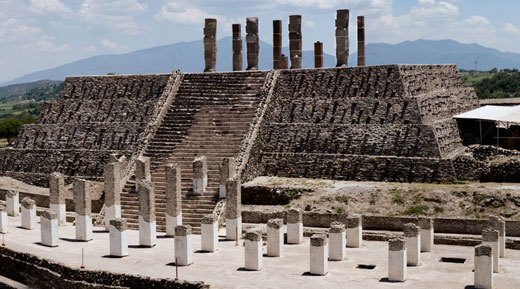 Pyramid B - Tula
Pyramid B - Tula
I also wanted to show how incredibly steep the stairs are that lead to the top. This is not a place for people with vertigo. Only about half our group went to the top and a few of them came down on their fannies because if you tripped it would be game over.
But what a sight once you make it to the top. Aside from getting a great look at the Burnt Palace from above you see the four Atlanteans standing solemnly and as mysterious a group of statues as you’ll find anywhere in the world.
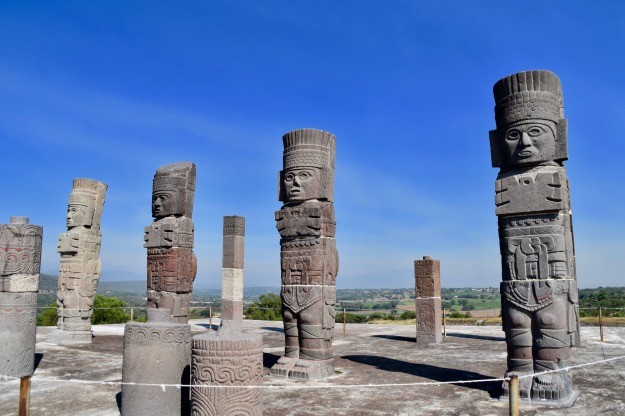 The Atlanteans at Tula
The Atlanteans at Tula
The Atlanteans are named not for Atlantis or the city in Georgia, but rather after the titan Atlas who was responsible for holding up the earth – he literally had the weight of the world on his shoulders.
These statues which are fifteen feet high once held up a roof of some sorts and so technically they are columns. There is no agreement as to their age which could be as early as 850 CE or as late as 1100 CE.
They are the best known Atlantean figures in Mexico, but others have been found at, no surprise, Chichén Itzá and in various parts of the Mexica (Aztec) empire.
Apparently these four statues had a tremendous influence on the Mexicas and are partly the reason the Mexicas believed the Toltecs to have been some sort of super race.
Let’s take a closer look at each Atlantean. As for as I can tell, they do not have individual names, but they are all slightly different, each representing a Toltec warrior in full battle dress.
 Atlantean 1
Atlantean 1
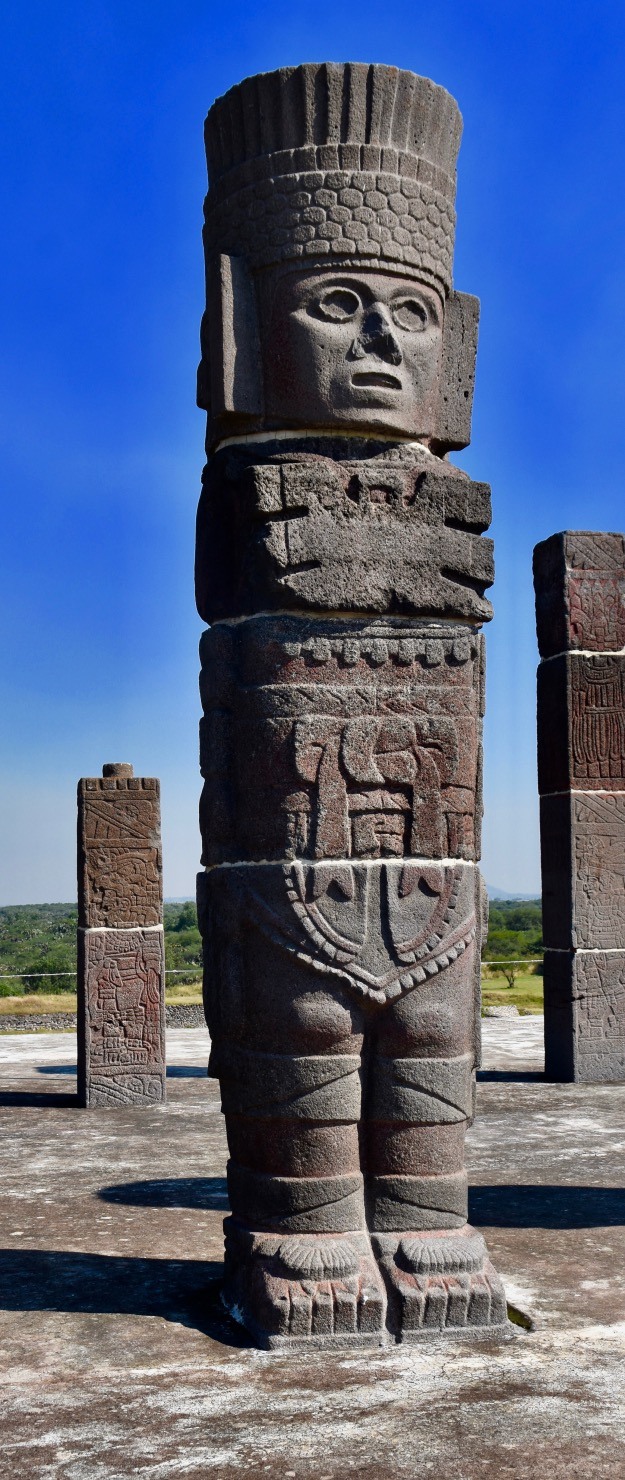 Atlantean 2
Atlantean 2
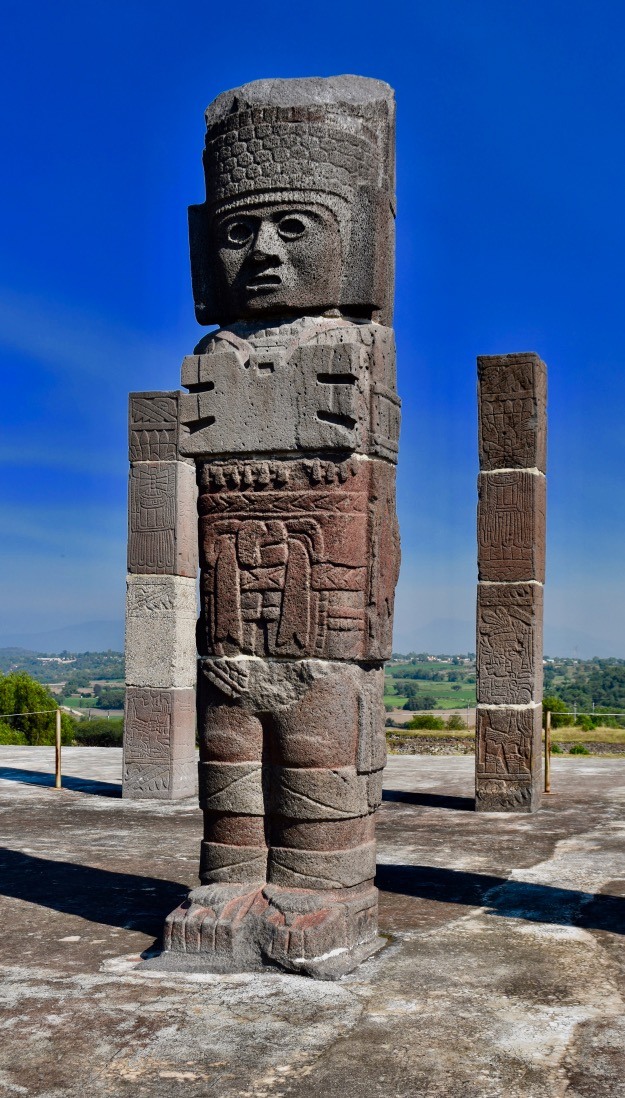 Atlantean 3
Atlantean 3
 Atlantean 4
Atlantean 4
It is on their backsides that you see major differences. This is a Mayan calendar on the back of Atlantean 1 and confirms the close relationship between the Toltecs and the Mayans.
 Mayan Calendar
Mayan Calendar
There are other more creepy practices associated with Tula such as this carving of serpents devouring skeletons.
 Serpents of Tula
Serpents of Tula
In reading the itinerary for this trip, one of things I most looked forward to was standing atop Pyramid B or more romantically, the House of the Morning Star, and seeing the Atlanteans gaze out over the high plains of central Mexico. Believe me, it was worth the somewhat scary climb to the top and the far more scarier descent and I have the photo to show we did it. You should get one too.
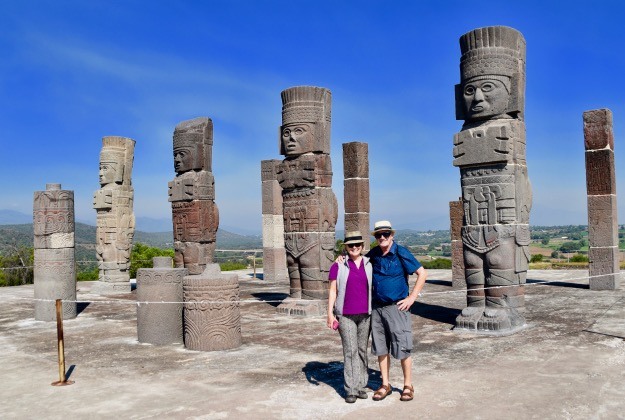 With the Atlanteans at Tula
With the Atlanteans at Tula
Next we venture to San Miguel Allende, a small colonial city considered to be among the most beautiful in Mexico and much favoured by Canadian expats and snowbirds.
Many thanks again to Dale of The Maritime Explorer for allowing us to share his wonderful insights.
Have a look at our Mexico sightseeing tours to experience this great country! Want to read more of our travel tales from Mexico? Check out these Mexico travel blog posts!